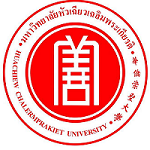กรุณาใช้ตัวระบุนี้เพื่ออ้างอิงหรือเชื่อมต่อรายการนี้:
https://has.hcu.ac.th/jspui/handle/123456789/4059| ชื่อเรื่อง: | Potent Trypanocidal Curcumin Analogs Bearing a Monoenone Linker Motif Act on Trypanosoma brucei by Forming an Adduct with Trypanothione |
| ผู้แต่ง/ผู้ร่วมงาน: | Abdulsalam A.M. Alkhaldi Darren J. Creek Hasan Ibrahim Dong-Hyun Kim Neils B. Quashie Karl E. Burgess Chatchawan Changtam Michael P. Barrett Apichart Suksamrarn Harry P. de Koning ชัชวาลย์ ช่างทำ อภิชาต สุขสำราญ University of Glasgow. College of Medical, Veterinary and Life Sciences Aljouf University. College of Science University of Melbourne. Bio21 Institute Sebha University. Department of Zoology University of Nottingham. School of Pharmacy University of Ghana Medical School. Centre for Tropical Clinical Pharmacology and Therapeutics Huachiew Chalermprakiet University. Faculty of Science and Technology University of Glasgow. Wellcome Trust Centre for Molecular Parasitology Ramkhamhaeng University. Faculty of Science University of Glasgow. College of Medical, Veterinary and Life Sciences |
| คำสำคัญ: | Curcuminoids เคอร์คูมินอยด์ Curcuma longa L. ขมิ้นชัน Trypanosoma brucei ทริปาโนโซมา บรูเซีย Trypanothione, antiparasitic activity ฤทธิ์ต้านเชื้อแบคทีเรีย |
| วันที่เผยแพร่: | 2015 |
| แหล่งอ้างอิง: | Molecular Pharmacology 87, 3 (March 2015) : 451-464 |
| บทคัดย่อ: | We have previously reported that curcumin analogs with a C7 linker bearing a C4-C5 olefinic linker with a single keto group at C3 (enone linker) display midnanomolar activity against the bloodstream form of Trypanosoma brucei. However, no clear indication of their mechanism of action or superior antiparasitic activity relative to analogs with the original di-ketone curcumin linker was apparent. To further investigate their utility as antiparasitic agents, we compare the cellular effects of curcumin and the enone linker lead compound 1,7-bis(4-hydroxy-3-methoxyphenyl)hept-4-en-3-one (AS-HK014) here. An AS-HK014–resitant line, trypanosomes adapted to AS-HK014 (TA014), was developed by in vitro exposure to the drug. Metabolomic analysis revealed that exposure to AS-HK014, but not curcumin, rapidly depleted glutathione and trypanothione in the wild-type line, although almost all other metabolites were unchanged relative to control. In TA014 cells, thiol levels were similar to untreated wild-type cells and not significantly depleted by AS-HK014. Adducts of AS-HK014 with both glutathione and trypanothione were identified in AS-HK014–exposed wild-type cells and reproduced by chemical reaction. However, adduct accumulation in sensitive cells was much lower than in resistant cells. TA014 cells did not exhibit any changes in sequence or protein levels of glutathione synthetase and γ-glutamylcysteine synthetase relative to wild-type cells. We conclude that monoenone curcuminoids have a different mode of action than curcumin, rapidly and specifically depleting thiol levels in trypanosomes by forming an adduct. This adduct may ultimately be responsible for the highly potent trypanocidal and antiparasitic activity of the monoenone curcuminoids. |
| รายละเอียด: | สามารถเข้าถึงบทความฉบับเต็ม (Full Text) ได้ที่ : https://www.sciencedirect.com/science/article/abs/pii/S0026895X24030359 |
| URI: | https://has.hcu.ac.th/jspui/handle/123456789/4059 |
| ปรากฏในกลุ่มข้อมูล: | Science and Technology - Articles Journals |
แฟ้มในรายการข้อมูลนี้:
| แฟ้ม | รายละเอียด | ขนาด | รูปแบบ | |
|---|---|---|---|---|
| Potent-Trypanocidal-Curcumin-Analogs-Bearing-a-Monoenone-Linker-Motif .pdf | 80.16 kB | Adobe PDF | ดู/เปิด |
รายการทั้งหมดในระบบคิดีได้รับการคุ้มครองลิขสิทธิ์ มีการสงวนสิทธิ์เว้นแต่ที่ระบุไว้เป็นอื่น
